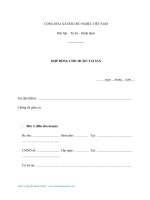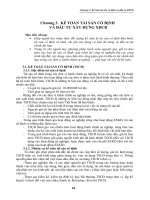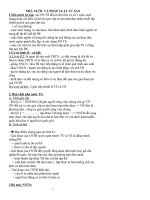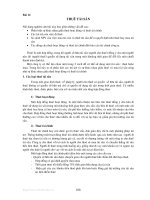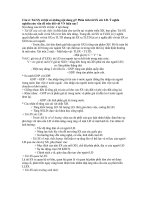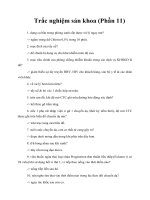Tài liệu Tài liệu: THUẾ TÀI SẢN pptx
Bạn đang xem bản rút gọn của tài liệu. Xem và tải ngay bản đầy đủ của tài liệu tại đây (297.75 KB, 36 trang )
THUẾ TÀI SẢN
Thuế tài sản là gì?
Property tax, millage tax is an ad valorem tax that an owner of real
estate or other property pays on the value of the property being taxed.
There are three species or types of property: Land, Improvements to
Land (immovable man-made things), and Personalty (movable man-
made things). Real estate, real property or realty are all terms for the
combination of land and improvements.
The taxing authority requires and/or performs an appraisal of the
monetary value of the property, and tax is assessed in proportion to
that value. Forms of property tax used vary between countries and
jurisdictions.
The property tax rate is often given as a %. It may also be
expressed as a ‰ (dollars of tax per $1000 of value), which is also
known as a millage rate or mill levy. (A mill is also $1000.)
Ví dụ
A property with an assessed value of $50,000
located in a municipality with a mill rate of 20
mills (20‰) would have a property tax bill of
$1,000 per year
Propert
y tax
=
The monetary
value of the
property
×
Property
tax rate
Lý do đánh thuế tài sản
Lý do tài chính
Người có càng nhiều (giá trị) tài sản thì càng có khả năng tài
chính lớn.
Lý do xã hội và chính trị
Giảm tập trung tài sản vào một cá nhân là mong ước của các
chính khách và hoạt động xã hội.
Lý do lợi ích
Người có nhiều tài sản cần chính phủ hơn người ít tài sản.
Dùng thuế tài sản tài trợ cho quốc phòng;
Một con đường khi hoàn thành sẽ làm tăng giá nhà;…
Lý do điều chỉnh (Điều chỉnh những khiếm khuyết của thuế thu nhập)
Lợi nhuận phát sinh trên một tài sản chưa bán thì không thể đánh
thuế thu nhập.
Câu hỏi
Phân biệt thuế tài sản và thuế thu nhập cá nhân
Phụ lục
CƠ BẢN VỀ THUẾ
TÀI SẢN TẠI MỸ
In a given jurisdiction Two moving parts
A. The Levy
Local budget (spending)
less (−) : Non-property tax revenue (incl. state aids)
equals (=): Total property tax levy (collections)
B. The Distribution of the Levy across
properties
Estimated market value
times (×): Applicable Class Rate(s)
equals (=): Taxable value
Two Basic Moving Parts
Simple Example of Property
Tax Mechanics four
jurisdictions
County
Khu học xá
(School district)
Khu kiểm soát
muỗi (Mosquito
district)
City
Your home
Levy Taxable Value Tax Rate
(aka, Tax Capacity*) (levy/taxable
value)
(millions)
School $ 16.0 $ 27.0 16/27 =
59.3%
County 20.0 50.0 20/50 = 40.0
City 2.3 19.0 2.3/19 = 12.1
Mosq. 0.6 12.3 0.6/12.3 = 4.9
Total Tax Rate (on your home)
116.3%
(*Tax Capacity = Est. Market Value x Class Rate)
Mechanics, cont’d
Tax on Your Home:
Your Est. Market Value $240,000
× Residential Class Rate 0.01
= Your Tax Capacity $ 2,400
× Your local tax rate 116.3%
= Your property tax (before credits) $ 2,791
(*Tax Capacity = Est. Market Value x Class Rate)
Mechanics, cont’d
Minnesota Statute 272.03 defines “market value” as “the usual selling price
at the place where the property is at the time of assessment.” It is “the price
that could be obtained at a private sale or an auction sale, if the assessor
determines that the price from an auction sale represents an arms-length
transaction. The price obtained at a forced sale shall not be considered.”
Market value = The price that would prevail under competitive open-market
conditions
Property tax – simple mechanics
Unlike income and sales taxes,
Property tax collections are set in advance, and
the tax rate is determined by dividing collections by
total taxable value of property in the taxing
jurisdiction
Therefore: exemptions for some properties
means other properties pay more.
This is a unique aspect of the American property
taxes
Unclassified system
Two Moving Parts – Levy vs. Distribution
Classified system
Business tax
Home tax
The local levy
A
The levy determines the overall community tax burden
Point A depicts the average property tax burden (effective tax rate)
Lack of classification creates a uniform effective tax rate (level A)
Classification raises the effective rate for some properties, reduces it for others
OVERVIEW OF PROPERTY
ASSESSMENT AND
TAXATION IN THE
NORTHWEST
TERRITORIES
The Assessment and Taxation Process
Property assessment and taxation is a
two-step process:
1. Assessment of property is the first step, where the
value and classification of properties is
determined, and any exemptions from assessment
are determined.
2. Application of tax rates is the second step. Taxing
Authorities apply tax rates (mill rates) to the
assessed value of properties to determine the
amount of taxes that are owed to the taxation
authority.
Step 1:
Property Assessment in the Northwest Territories
The Minister of Municipal and Community
Affairs (MACA) is the property assessment
authority.
MACA performs property assessments in all
NWT communities.
What is property assessment?
Property assessment is the process used to assign a
value to all assessable properties.
Property assessment is made up of two components:
Land value and Improvements value.
Improvements may include buildings, machinery and equipment.
Personal property such as jewelry, cars, televisions and
other personal possessions are not assessed.
How is property assessed?
Property assessors conduct property assessment according to the
Property Assessment and Taxation Act (PATA) and Regulations.
Property assessors determine the value of each property by
inspecting the land and the improvements located on the land.
Characterizing these components, such as municipal zoning, type of
construction and age.
They also use of a series of property assessment cost manuals to
ensure the assessments are fair and equitable across the NWT.
The Assessment Formula
Improvement Assessment
+
Land Assessment
_____________________
= Total Assessment
Why do assessments increase or
decrease in value?
Changes in the assessed value reflect changes in
property value. Some of the reasons that value can
change are:
property may have been improved due to a renovation or an
addition (or removal)
demand for property in the neighborhood may cause prices
and market values to rise or fall
a change in zoning may have increased or decreased the
value of the land
Annual and General Assessments
There are two types of property assessments: Annual
Assessments and General Assessments.
Annual Assessments are assessments to capture annual
improvement changes to properties, such as additions,
renovations or deletions, or the addition of new
properties.
General Assessments must be completed at least once
every ten years. These assessments set the base year for
assessment calculations. This allows equity between
improvements of varying ages.
What is an Assessment Roll and how is
it created?
An Assessment Roll is a listing of all assessable
properties in a taxation area, usually by community.
The Roll contains summary assessment information for
each property.
Several versions of the Roll are created each year as
new information comes forward, corrections are made
and decisions are made concerning property owner
appeals.
The Assessment Roll is a public document, and can be
viewed at the community office.
The Assessment Roll 2
nd
Revision is transferred to the
taxation authority for the calculation of property taxes.
What is an Assessment Notice?
The Assessment Notice gives the pertinent property
assessment information, such as legal description, owner’s
name, assessed value, property classification and tax code.
A property owner should review all the information on the
Assessment Notice to ensure correctness and to compare to
other similar properties on the Assessment Roll.
The Assessment Notice also gives instructions on how and
when an appeal can be filed.
Each year MACA prepares Assessment Notices and
delivers them to individual property owners for every
assessed property.
What if the property owners have a complaint about the
information or assessed value of their property?
Property owners can appeal to the Territorial
Board of Revision or their respective Municipal
Taxing Authority Board of Revision.
If not satisfied with the Board of Revision’s
decision, property owners may further appeal to
the NWT Assessment Appeal Tribunal.
The final level of appeal is to the Supreme
Court of the Northwest Territories.
When should a complaint be filed?
Property Owners must file an appeal within 45 days of
the mailing date on the Assessment Notice.
Factors which warrant the filing of an appeal include:
errors of fact including structure description, quality,
property classification, size, depreciation and land
zoning;
perceived errors in assessment calculations;
differences between your assessment and similar
properties in your neighbourhood.
Step 2:
Property Taxation in the Northwest Territories
The Minister of Finance is the property taxation
authority.
The Department of Finance collects property
taxation in all NWT communities with the
exception of the communities of Yellowknife,
Fort Smith, Hay River, Fort Simpson, Norman
Wells and Inuvik. These communities have
been delegated property taxation authority
within their own boundaries, and collect their
own taxes.


